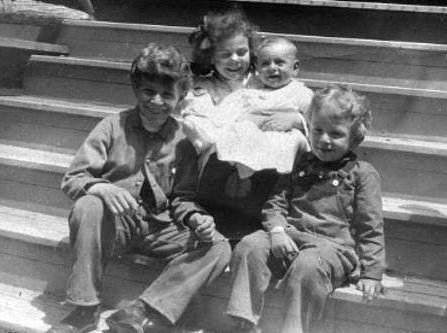
 Recently, Diane O’Connor, the managing director of the Lower Adirondack Regional Center for History in Ticonderoga, presented “Adirondack Jews: Community and Contribution,” at the Historical Society of the Town of Chester and the Town of Chester Library. The program highlighted the contributions of the Marshall family – Louis Marshall and his sons James, George and Bob – to the preservation of the Adirondacks.
Recently, Diane O’Connor, the managing director of the Lower Adirondack Regional Center for History in Ticonderoga, presented “Adirondack Jews: Community and Contribution,” at the Historical Society of the Town of Chester and the Town of Chester Library. The program highlighted the contributions of the Marshall family – Louis Marshall and his sons James, George and Bob – to the preservation of the Adirondacks.
Louis Marshall helped frame New York’s constitutional clause declaring forest preserve lands ‘forever wild. Bob Marshall, developed the first federal wilderness classification system. George was a leader of the
Wilderness Society and the Sierra Club, and James was a founding director of the Adirondack Council.
The contributions to our understanding of the value of wilderness made by the Marshall brothers have tended to obscure their father’s part in protecting that wilderness.

 In 1894, Louis Marshall was a delegate to New York State’s constitutional convention. A young but promising attorney from Syracuse, he arrived focused on the judiciary, intent on making the court system more rational. But he worked even harder to make the 1885 legislation protecting the Adirondack Forest Preserve a permanent part of the state constitution.
In 1894, Louis Marshall was a delegate to New York State’s constitutional convention. A young but promising attorney from Syracuse, he arrived focused on the judiciary, intent on making the court system more rational. But he worked even harder to make the 1885 legislation protecting the Adirondack Forest Preserve a permanent part of the state constitution.
“If I were asked to state what the most important action of the Convention of 1894 was, I should say without the slightest hesitation that it was the adoption of the article which preserved in their wild state the Catskills and the Adirondacks,” Marshall said at another constitutional convention, one held twenty years later in 1915.
And, he went on to say, “the most important question which is to be acted upon by the 1915 Convention” was a proposal to amend the forever-wild clause to allow timber to be harvested in a large part of the Adirondack Forest Preserve.
“What would you have left after you adopted a provision of this character? Nothing but a howling wilderness. Not a wilderness of trees – of wild forest trees – but of stumps, enough to make one’s heart sick to behold them,” Marshall told the delegates.
Thanks in part to conservationists such as Lake George’s John Apperson, who organized a coalition of sportsmen, legislators and civic leaders to support Marshall, the attempt to dilute the forever-wild clause was defeated.
According to historian Phil Terrie, the vote at the 1915 convention was as significant as the decision in 1894 to constitutionally protect the Forest Preserve. Marshall and his fellow delegates ratified that decision,
demonstrating that it was not a hasty or ill-considered one, thus ensuring that the forever-wild clause would remain a part of the constitution.
“The affirmation of the forever-wild clause at the 1915 constitutional convention served to re-emphasize. that most of the people of New York wanted the Adirondacks to continue to be predominantly a place of nature,” Terrie wrote in Contested Terrain.
After the convention adjourned, Marshall continued to defend the integrity of the forever-wild clause and support the cause of conservation wherever he could, including, even, drafting legislation to protect roadside wildflowers.

 Conservation, however, was only one of his many concerns and his writings on the topic occupy a relatively small portion of his papers, a two-volume edition of which was published in 1957. But, however much he achieved in the world as a constitutional lawyer, a civil rights advocate and a supporter of Jewish causes, no place was more important to him than the Adirondacks.
Conservation, however, was only one of his many concerns and his writings on the topic occupy a relatively small portion of his papers, a two-volume edition of which was published in 1957. But, however much he achieved in the world as a constitutional lawyer, a civil rights advocate and a supporter of Jewish causes, no place was more important to him than the Adirondacks.
“He delighted in the rustic joys of Knollwod, a hilly woodland overlooking Lower Saranac Lake,” wrote one of his biographers. “There he a attained a degree of intimacy with his family difficult to maintain in the city. There he composed the satires, the dialect sketches and the cozy poetry that were among the tokens of affection that bound him to his wife and children.”
And from there he issued this plea on behalf of the Adirondacks: “Let us preserve some of the simple things. Let us know that there is somewhere in our state a region not yet commercialized and citified, and to which people may repair who yearn for a restoration amid the vast silences of the eternal mountains and the primeval forests. Let us beware while there is still time. Let us not jeopardize this fine heritage. Let
us not make a beginning which in time would be certain to make a barren waste of the most perfect mountain region in the world.”
Those words inspired his sons and continue to inspire advocacy groups such as the Adirondack Council, which presented its Conservationist of the Year award in 2014 to the descendants of Louis Marshall.
Louis Marshall died in Zurich, Switzerland in 1929.
A version of this article first appeared on the Lake George Mirror, America’s oldest resort paper, covering Lake George and its surrounding environs. You can subscribe to the Mirror HERE.
Illustrations, from above: James, Ruth, George, and Bob Marshall at Knollwood (courtesy of David Marshall Billikopf); Louis Marshall; and the old boathouse at Knollwood, the camp on Lower Saranac Lake built for the Marshalls and some of their friends.









Recent Comments